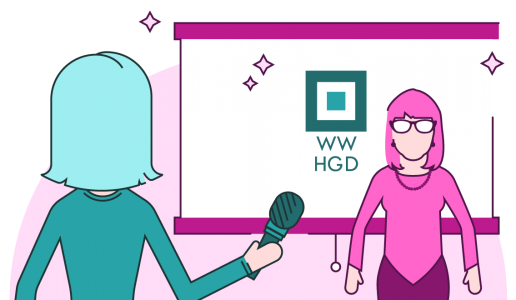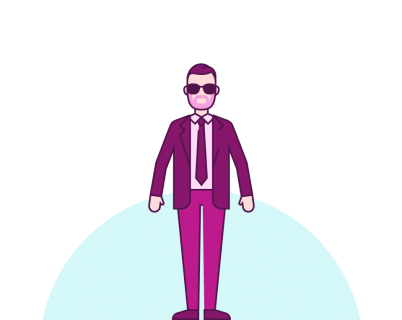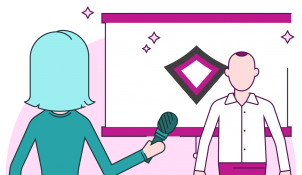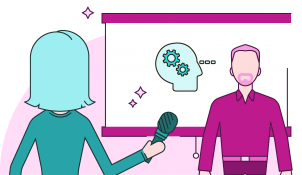Jamie Garroch puts the ‘power’ in PowerPoint add-ins. He’s written code for dozens of amazing functionality boosters, some for specific organizations and some available for all users, and he's joining the BrightCarbon team! Read on to learn about the experience that Jamie is bringing to BrightCarbon and how it will help clients and the presentation community use PowerPoint more effectively.
Insights from an in-house presentation expert: Q&A with Sherri Hodge
- Written by: Kieran Chadha
- Categories: Industry insights
- Comments: 1

As a presentation agency, we at BrightCarbon understand how beneficial it can be for organizations to have an in-house presentation expert, although most companies don’t. This year at Training Magazine Conference I had the opportunity to meet Sherri Hodge, an in-house PowerPoint expert. Since she first joined the workforce as a secretary early in her career, Sherri has worked with marketing teams at engineering and manufacturing companies, until ultimately finding herself at Weinberg, Wheeler, Hudgins, Gunn, & Dial. WWHG&D is a national trial law firm in the United States, where Sherri works as a Training Specialist and supports attorneys who need presentations. Even though they keep her busy, I was able to steal her for an hour to discuss her career arc, the nature of her current role, and her presentation philosophies.
Q: As a presentation professional I know that it’s typically not the career path you set out to do, rather you become a presentation expert in a roundabout way. Can you talk a little bit about how you got your first job?
A: I was in the United States Airforce. I joined to go to college, but got married instead, so everything I’ve learned has been self-taught. After my divorce, I had a great motivation to learn things because my ex told me I was going to fall flat on my face—there’s no better motivation than that! I was a single mom and I had to support my daughter, so I started working as a secretary.
Q: Admittedly, I did a bit of stalking on your LinkedIn, and you reference being pushed to do more after someone dismissed you when you tried to help. Can you speak to this a bit more? What about this inspired you to go for your CPS (Certified Professional Secretary) and then ultimately your MOS (Microsoft Office Certification)?
A: I was worried about trying to find a solution for a client, and the service manager told me not to worry about it, I was ‘just a secretary’. Those are probably the most insulting words you can say to a person, is to describe them as ‘just an’ anything. So, I went and enrolled in a CPS course and passed that, then I was like, ‘What else can I do?’ My next job was working with engineers and I had the chance to get some training on Microsoft Access. Now, who thought that would lead into [becoming a training professional]? I started with Access, then I got my MOS certification in Word and in PowerPoint.
Q: How did these skills help you transition into starting a career in training and presentations?
A: Eventually, I moved to the marketing team with a group of manufacturers and did presentations and [Microsoft] Access database. They eventually eliminated my position because you could do anything over the internet so you didn’t really need a marketing coordinator anymore. But, a co-worker knew an attorney [at my current firm], so I sent over my resume, they hired me to do the helpdesk and now it’s 12 years that I’ve been with this firm!
Q: What experience or opportunities did you seize to become a presentation expert? What were the stepping stones?
A: When I worked for the engineers I worked in the IT department. Each of us had a personal budget for $500 to either buy a book or attend a class as long as it was related to IT. How smart that they put the responsibility on you to learn, not on them to teach you! So, I took advantage of that and I’ve never stopped.
One of the biggest helps for me has been the books [associated with software]. If you put software in front of me I’m curious about it. Anytime a new series would come out [like Microsoft 2010], I would buy the Bible, and as my husband watches The Food Channel I’ll read through it and put a little sticky note next to anything that looks interesting and to remember for later. You can go to the internet, but I’m an old-fashioned learner: I like to read the book.
Q: This is a new husband I take it then!
A: Yes, he’s the new husband, we’ve been married 21 years. He likes me a lot!
Q: New career, new husband, happy to hear that! As for your current role, what do you think the advantages of having an in-house training specialist are? What do you think it says about your law firm that they’ve invested in you?
A: I think the benefit to the firm is that I give them immediate access to changes and they are immediately available if I have a question; that alone saved them a lot of money and time. As far as them developing this role inside the firm, it’s very forward-thinking. We have someone that does our web and worked on the branding, and they pulled me in to work on that because what I develop is client-facing, too and it’s all got to match.
Q: At Weinberg, Wheeler, Hudgins, Gunn, & Dial, are you a one-woman department?
A: There’s 5 of us: systems administrator, IT manager, team leader, Tier I helpdesk person, and myself. We’re very small compared to other law firms, even of our own size. I’m the only one that does the presentations; I am their go-to PowerPoint question person.
Q: What kind of work do you get your hands into weekly?
A: Every week I try to create an ‘IT Quick Solutions’ video, which is a quick overview on how to do something like advanced sorting in Excel. A law firm’s main application is Word, secondary, PowerPoint, and down the line is Excel. They’re working more and more in Excel but they didn’t grow up with that knowledge like they grow up with Word. My videos have been focusing on Excel recently. What’s really handy is I’m able to make them a link that’s connected to our document management system, and it allows me to see what’s being used, and what they don’t care about.
Q: What about larger, longer things that you try to work on?
A: I make presentations for mock trials which can be quite challenging. They’ll give me about 30 deposition videos and I’ll need to distill them down into something useable.
Once, I did something really fun. One of our attorneys in Miami did a Game of Thrones-themed presentation, and I took some graphics of dragons and put them over our logo and at the finish I had them flying away. It was cool! I love when an attorney comes to me with something like that. But, it has taken a while for me to build up a reputation where people say, ‘Hey Sherri, we trust you’.
Q: How do you change the way that your coworkers communicate with their clients, or maybe even with each other? Do you get to see how they’ve improved?
A: Once I hand the presentation off to them, they’re usually presenting it to a client or at mock trial or in court, so I really don’t see the end result. The biggest feedback for me is when they come to me and say, ‘Hey Sherri remember when you did that thing? We’re gonna do something like it again. Can you help us out?’ and that’s when I know it was a success. I’ve done good work, they like it, and the end result was good for them.
What I have got them to do for me, is when they say ‘Sherri I have a presentation I want you to do,’ my first question is, ‘When does it need to be done?’ and they’ve gotten really good about saying when it needs to be done. Because if they say ASAP I just ask them if its apple sauce or apple pie.
Q: So, you’ve also coached them to be better communicators with you, or to communicate their needs better?
A: Yeah, because if I think I have a week and you think I only have two days, that’s a problem! There’s still people that come and need it tomorrow, and I say, ‘Hmm … well are you gonna approve overtime because this is gonna take 8 hours and that’s 8 hours more than I have.’
To improve this, I have a questionnaire that we fill out together: When does it need to be done? Are there videos? Is there a stipulation as to the color theme? Can we be creative or is it mandated by the court? That way I know what they want and when they expect it. People know when they’re going to need things, but they just get busy and it’s like saying, ‘Oh my gosh Christmas is here!’ … no honey, we knew it was coming!
I have one attorney that I’ve worked with for so long that I’m at the point now where I’ve basically taught myself out of a client because they don’t need me anymore. To me, that’s the sign of a good teacher because my students no longer need me on a day-to-day basis.
Q: That must be so validating.
A: It is, but it takes two; it’s a good trainer and a good listener.
Q: Now I know that we both share the belief that presentations should be visual aids, and therefore need to be visual! Can you speak a little bit about why you think visual slides are so important, and how they’re different from the other deliverables you create?
A: If you can associate a picture with a word or phrase, then [the audience is] going to remember it more. For example, I had to make a slide about this one chemical; one cup of it will kill a 6ft man. So, rather than just saying that, I create a visual with this gorgeous hunky man—I had a lot of fun looking for him—and then just a tiny cup right next to him, that gives the proportion. If you must have bullet points, you need to keep them simple.
Q: While visuals are much more effective than text, they do require more effort on the part of the presenter. Are you often met with resistance when creating materials for your coworkers? Do you push back? If so, how?
A: I’ve not really met resistance, honestly. I point out to them that the words I’m taking out give more power to the words that are important and I think people understand that. They don’t resist much when they see that it’s for their benefit.
Q: I imagine that you frequently get decks or projects that need to be turned around quicker than you’d like. What tips or PowerPoint hacks are your absolute lifesavers when you need to get something looking good, fast?
A: In a situation like this, consistency is king. I set up everything as much as I can in the PowerPoint templates Master. One of my favorite tools is ‘Size and Position’. This is so important because if you have a shape or image that is supposed to be in the same place on every slide, and it shifts slightly, your eye notices that. You can get so distracted that you’ll struggle to even listen to what the speaker is saying because you’re trying to figure out what was wrong with the slide. So, you do right click -> Format Shape -> Size and Position to make sure that each object is exactly where it needs to be.
The problem is, people think the quality of your PowerPoint is the quality of what you’re saying. You could have great information, but if it looks unprofessional people are going to question the validity of your content. The presentation needs to be as polished as the presenter. I also never ever use the ‘Resize shape to fit text!’
Q: What kinds of things do you sacrifice to get something done on time?
A: If I had 2 hours to do something that normally takes 4 I’d be in a panic and I’d probably have a cup of coffee by my side! I would focus on the text position, formatting, and font sizes. I would forgo the editing process where I read the text for grammar consistency and seek to make the ideas concise on the slide, that type of editing.
Q: What do you wish that you had more time to work on? What kind of things would you do for your company if they gave you complete control of how you use your time and your team resources for 6 months?
A: If I was Queen of the Forest, I would take every secretary through complete PowerPoint training so that they’re comfortable with it. They often bypass working on presentations and send them along to me because of time constraints, and they also struggle with it. It isn’t that they cannot do the work; they don’t work in PowerPoint every day so they aren’t comfortable with the tools and the shortcuts. What I would really love to do is introduce all of the staff—including the attorneys—to all of the different skill levels and qualifications associated with becoming certified in Word and PowerPoint; not necessarily so they can do it themselves, but so they would know what is involved and have an appreciation of what’s being asked of their staff.
In my dream of dreams, I would love to have more time to complete my series of 5-minute videos. It would be a complete start to finish of A User’s Guide to PowerPoint or A User’s Guide to Excel. Sometimes, the attorneys will be working at 10 o’clock at night and they’ll go ‘Oh this is a Sherri question.’ Well, I can guarantee you she’s asleep!
There’s just so much you can do with PowerPoint that people don’t know. PowerPoint has had to compete with Adobe so you now have so many functions in PowerPoint that were previously only available in Illustrator. You can adjust photos, gray them out, crop them in funky ways, or even make them more artistic. PowerPoint’s graphic functions will allow you to take what’s there and adjust it to what you need it to be.
You know, years ago, back when Microsoft Office 97 came out, I was reading the book and kept going ‘Oh wow, you won’t believe this’, and my coworker said ‘Sherri, do you think you’ll ever lose your enthusiasm?’, and I said ‘… nah!’ and I never have!
Sherri Hodge is a Training Specialist / Instructional designer at Weinberg, Wheeler, Hudgins, Gunn & Dial, LLC. To learn more about her organization please click here: https://www.wwhgd.com/
Leave a comment

Kieran Chadha
Principal consultant; Head of BrightCarbon Academy
View Kieran Chadha's profileRelated articles
Insights from a graphics guru: Q&A with Mike Parkinson
An interview with Mike Parkinson, PowerPoint MVP, author, and businessman. Read how he juggles all his priorities, and how he views slow and steady growth as the key to his success.
- Presentation technology / Industry insights
- Comments: 2
think-cell is a PowerPoint add-on with chart and layout automation functions. Their latest update includes big data reporting capabilities and automatic layout generation. We got a special sneak preview of the latest version, and the inside scoop on the best features of the update from CEO and co-founder Markus Hannebauer.
Leave a Reply
Join the BrightCarbon mailing list for monthly invites and resources
Tell me more!As we were novice and non-marketing professionals, everyone took the time to explain and teach while also doing, which came in handy to feel more comfortable with what we were creating.
Marc Chaanine Jamaica Bearings




Sherri’s the best! I have departed the firm and I miss her strong capabilities as she bailed me out more than once while on the road.